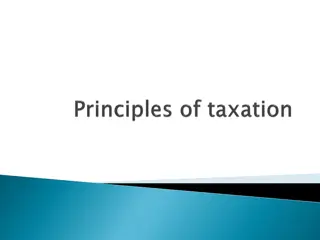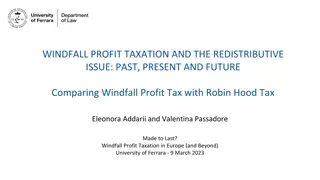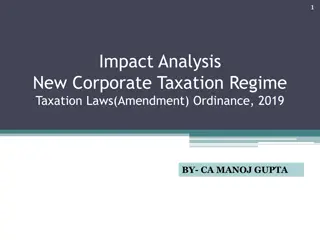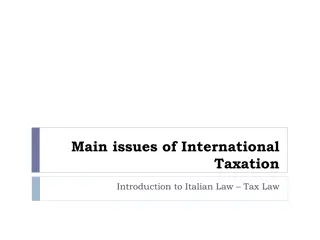Taxation Challenges in the Digital Economy
The increasing digitalization of the economy has raised significant tax challenges, with ongoing discussions among Revenue Authorities, Multinational Entities, and Advisory Bodies worldwide. This content delves into existing digital platforms, their role in the collection process, VAT taxation implications, direct tax issues, and solutions proposed to address the tax challenges of the digital economy.
Download Presentation

Please find below an Image/Link to download the presentation.
The content on the website is provided AS IS for your information and personal use only. It may not be sold, licensed, or shared on other websites without obtaining consent from the author.If you encounter any issues during the download, it is possible that the publisher has removed the file from their server.
You are allowed to download the files provided on this website for personal or commercial use, subject to the condition that they are used lawfully. All files are the property of their respective owners.
The content on the website is provided AS IS for your information and personal use only. It may not be sold, licensed, or shared on other websites without obtaining consent from the author.
E N D
Presentation Transcript
Content 1. Introduction; 2. Existing digital platforms; 3. digital platforms in collection process; 4. VAT taxation under digital economy; 5. Direct tax issues under digital economy/BEPs Action 1 - Addressing the tax challenges of the digital economy; 6. Challenges; 7. Way forward;
1. Introduction The question of how the increasingly digital economy will be taxed is under discussion by Revenue Authorities, Multinational Entities and Advisory Bodies alike around the world; There is no consensus on how this will be done not even at the level of the OECD, which is trying to lead global discussion on this subject;
2. Existing digital platforms Marketplaces: platforms that allow end-users on two different sides to interact (sellers and buyers) by associating with the platform, which facilitates the transaction between them; Resellers: platforms that acquire products from suppliers and resell them to customers; Pure intermediaries: platforms that allow suppliers to sell products independently through the platform. Suppliers and customers do not associate themselves with the platform and the platforms do not facilitate the interaction between them; Integrated platforms: platforms that have acquired the supply-side (e.g. supplier(s) of certain products) and have integrated these suppliers within their business;
3. digital platforms in collection process 1. Deemed supplier model - The digital platform is treated as having made the taxable supply and as having received the supply from the underlying supplier; 2. Transparent model - The digital platform is liable for collecting and remitting the VAT in the name and on behalf of the online supplier; 3. Withholding model - The digital platform withholds the VAT on the underlying supply as the withholding agent.
3. digital platforms in collection process Cont 4.VAT reverse mechanism 5. Required to have an agent/third party representative 6. Required to register 7. Request financial intermediaries to withhold;
4. VAT taxation under digital economy cont B2B on imported goods ( taxed at customs point); B2B on imported services (taxed through VRC); B2B on intangibles ( are intangibles goods or services);
4. VAT taxation under digital economy cont B2C on imported goods ( taxed at customs point); B2C on imported services (Not taxed); B2C on intangibles (Not taxed);
5. Income tax issues under digital economy The income tax issues have all been addressed in: The Transfer Pricing; Permanent establishment; Controlled foreign company work streams;
5. Other unilateral new tax measures proposed under BEPS Action 1 Digital Nexus Digital Nexus- this allows for rules to tax profits from remote vendors where there would not otherwise be taxable presence; Withholding taxes on digital transactions; Equalization levies intended to neutralize the perceived advantages of digital businesses;
6. Challenges 1. Registration; 2. Input tax recovery Refunds; 3. Returns; 4. Payments; 5. Invoicing; 6. Information sharing;
7. Way forward 1. Replacing PE with significant presence One potential option proposed would be to replace the existing significant presence test intended to respond to the changing nature of customer relationships in the digital economy while continuing to rely in part on physical presence; PE concept with a
7. Way forward Cont 2. Creation of a withholding tax on digital transactions Another potential option that has been suggested to address challenges related to nexus is to impose a final withholding tax on certain payments made by residents of a country for digital goods or services provided by a foreign provider;
7. Way forward Cont 3. Government institutions to apply VAT reverse charge; 4. Apply the principal of international VAT guidelines; 5. Amend DTA of Rwanda and Belgium especially in its Article 13 where it is stated that Rwanda have taxing rights on technical services when those services are exercised in Rwanda;























